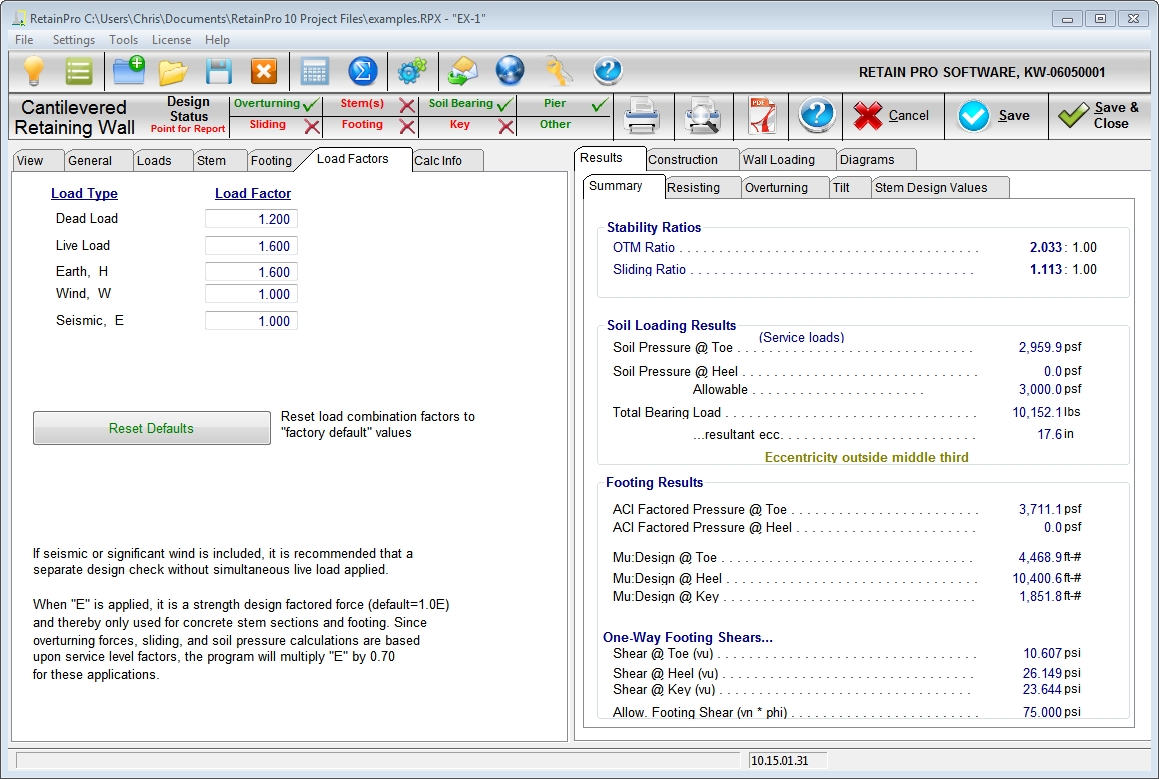Summary |

|

|
Summary
This screen summarizes the footing/soil bearing results obtained from previous screens, including a message whether the resultant is within or outside the middle third of the footing. This is not an input screen. It's strictly for your review.

Stability Ratios: These are displayed for both overturning and sliding.
Soil Loading Results
| Soil Pressure @ Toe and Heel: | This is the resulting soil pressure for both the toe and heel based on service loads. If the eccentricity is outside the middle third, the heel pressure will show 0.00, and the program will calculate the toe pressure assuming no tension at the heel. |
| Allowable Soil Pressure: | This is for reference as entered on the General tab. |
| Total Bearing Load: | This is the sum of all vertical forces. |
| Resultant Eccentricity: | Distance from center of footing to the resultant of the soil pressure distribution. |
Eccentricity Within/Outside Middle Third: If the eccentricity is greater than one-sixth the footing width, the resultant is outside the middle third. (If outside the middle third, the program computes the toe soil pressure assuming no tension at the heel.)
Footing Results
ACI Factored Soil Pressure @ Toe and Heel: ACI load factors are applied to all loads to determine total vertical load for soil pressure used in calculating footing moments and shears. This load is then applied at the same eccentricity calculated for service load soil pressures to yield the factored soil pressures for footing design using LRFD design principles.
| Note that since factored vertical loads are applied at the non-factored resultant eccentricity, a true 1.6 load factor applied to lateral earth pressure is not used for footing design. ACI load factors are intended to give conservative results for design. Calculation of a factored load eccentricity would give soil pressure diagrams that would not always represent the actual soil pressure distribution under the footing, and yield unreasonable results. Factored lateral earth pressure, however, is always used for concrete stem design. |
| Mu Design @ Toe/Heel: | These are the factored moments at face of stem for toe and heel moments. Since neither can be greater than the stem base moment (factored if concrete stem), the latter may govern. These moments will be reduced if you choose to neglect the upward soil pressure on the Footing tab. A message will indicate which controls. |
| Shear @ Toe and Heel: | These items report the factored shear stress from the one-way action in the footing. The toe shear stress is calculated at a distance "d" (footing thickness - rebar cover) from the face of the bottom stem segment. (If "d" is greater than the projecting toe length, then the one-way toe shear is reported as zero.) The heel shear stress is calculated at the face of the stem. |
Allowable Footing Shear: The design shear strength calculated as (0.75 * 2 * λ * f'c½).